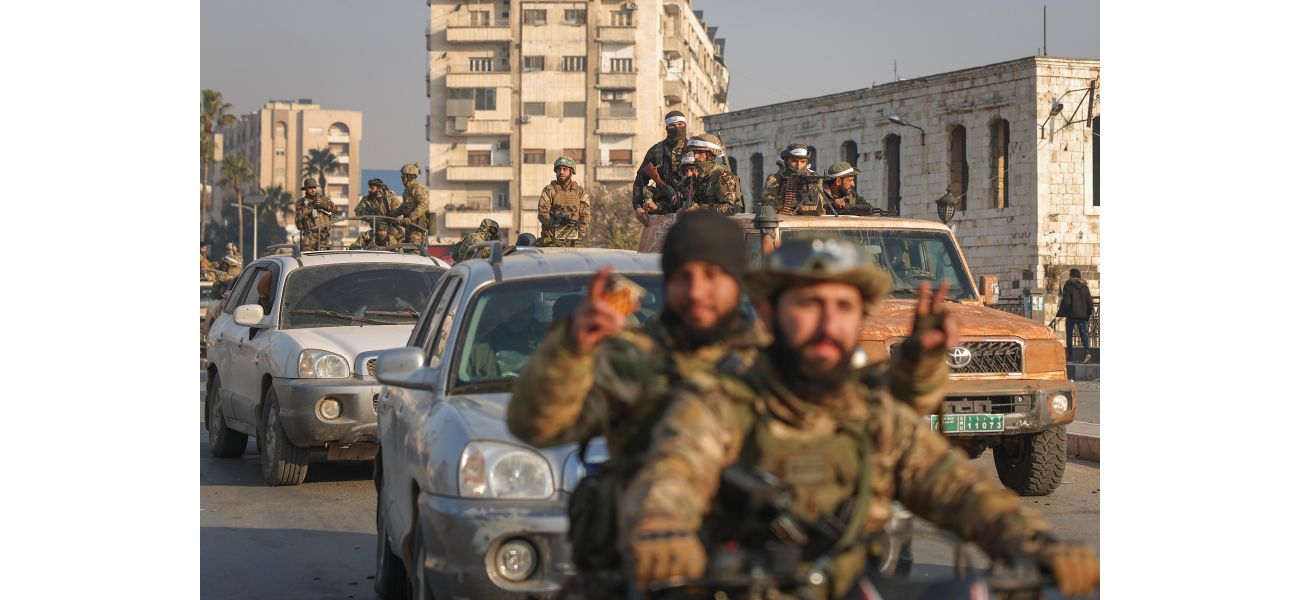Who are the opposition forces at the gates of Damascus and what will happen next?
In the past 10 days, Bashar Assad and his government have experienced a dramatic change in their fortunes.
December 7th 2024.

In a recent turn of events that has caught the world by surprise, opposition fighters are quickly approaching Syria's capital in what is quickly becoming a major crisis. The Syrian army has surprisingly retreated from key cities with minimal resistance, leaving nervous residents in Damascus reporting sightings of security forces on the streets. In an attempt to quell rumors that President Bashar Assad has fled the country, the state news agency has been forced to deny such claims.
But who exactly are these opposition fighters? And what will happen if they successfully enter Damascus after already seizing control of some of Syria's largest cities? Let's take a closer look at the dramatic turn of events that has transpired over the past 10 days, and what may lie ahead as Syria's 13-year civil war reignites.
The main objective of these opposition forces is to overthrow the current government. This marks the first time since 2018 that they have come close to the outskirts of the Syrian capital, after being pushed back by government troops following a long siege. The approaching fighters are led by Hayat Tahrir al-Sham (HTS), the most powerful insurgent group in Syria, along with an umbrella group of Syrian militias backed by Turkey known as the Syrian National Army. The shock offensive was launched on November 27th, with gunmen taking control of Aleppo, the largest city in Syria, as well as the fourth largest city, Hama.
It is worth noting that the origins of HTS can be traced back to al-Qaida, which has led the U.S. and the United Nations to label them as a terrorist organization. However, the group has publicly stated in recent years that they have severed ties with al-Qaida. Experts believe that HTS has been working to rebrand themselves by not only focusing on military action, but also promoting civilian government in the areas under their control.
In an exclusive interview with CNN, HTS leader Abu Mohammed al-Golani revealed that the main objective of the offensive is to overthrow Assad's government. However, there may be potential rifts between HTS and the Syrian National Army, who have been both allies and rivals in the past. The Turkish-backed militias also have their own interests, including creating a buffer zone near the Turkish border to keep Kurdish militants away. While Turkey has been a supporter of the fighters seeking to overthrow Assad, they have recently called for reconciliation and vehemently denied any involvement in the current offensive.
Meanwhile, other armed opposition groups have also mobilized in different parts of the country. In the south, areas like Sweida and Daraa have fallen to local opposition forces. Sweida is home to Syria's Druze religious minority and had been a site of regular anti-government protests even after Assad's forces regained control. Daraa, on the other hand, is a Sunni Muslim area and was the birthplace of the uprising against Assad's rule in 2011. Although the government regained control of Daraa in 2018, rebels remained in some areas. In recent years, the area has been relatively quiet under a Russian-mediated ceasefire deal. Additionally, much of Syria's east is controlled by the Syrian Democratic Forces, a Kurdish-led group supported by the U.S. who have clashed with most other armed groups in the country.
As a result of these recent developments, the Syrian government now only has control of three out of 14 provincial capitals: Damascus, Latakia, and Tartus. The next steps will largely depend on Assad's actions and the willingness of his forces to continue fighting against the rebels. A commander from the opposition forces has announced on the messaging app Telegram that they have begun the "final stage" of their offensive by surrounding Damascus. In addition, Syrian troops have reportedly withdrawn from much of the central city of Homs, the third largest city in Syria. If this city falls, it would cut off the link between Damascus and the coastal region where Assad enjoys widespread support.
With allies like Russia and Iran currently preoccupied with other conflicts, and Hezbollah weakened by their war with Israel, Assad appears to be largely on his own in this situation. The U.N. special envoy for Syria, Geir Pedersen, is seeking urgent talks in Geneva to ensure a peaceful political transition, as the situation on the ground is constantly changing. He has already met with foreign ministers and senior diplomats from eight key countries, including Saudi Arabia, Russia, Egypt, Turkey, and Iran, during the Doha Summit. Even President-elect Donald Trump has weighed in, stating that the besieged Assad does not deserve U.S. support to remain in power.
In the midst of this rapidly evolving crisis, it remains to be seen what the future holds for Syria and its people. The next few days and weeks will be crucial in determining the course of this 13-year-long civil war. Only time will tell what lies ahead for this war-torn nation.
But who exactly are these opposition fighters? And what will happen if they successfully enter Damascus after already seizing control of some of Syria's largest cities? Let's take a closer look at the dramatic turn of events that has transpired over the past 10 days, and what may lie ahead as Syria's 13-year civil war reignites.
The main objective of these opposition forces is to overthrow the current government. This marks the first time since 2018 that they have come close to the outskirts of the Syrian capital, after being pushed back by government troops following a long siege. The approaching fighters are led by Hayat Tahrir al-Sham (HTS), the most powerful insurgent group in Syria, along with an umbrella group of Syrian militias backed by Turkey known as the Syrian National Army. The shock offensive was launched on November 27th, with gunmen taking control of Aleppo, the largest city in Syria, as well as the fourth largest city, Hama.
It is worth noting that the origins of HTS can be traced back to al-Qaida, which has led the U.S. and the United Nations to label them as a terrorist organization. However, the group has publicly stated in recent years that they have severed ties with al-Qaida. Experts believe that HTS has been working to rebrand themselves by not only focusing on military action, but also promoting civilian government in the areas under their control.
In an exclusive interview with CNN, HTS leader Abu Mohammed al-Golani revealed that the main objective of the offensive is to overthrow Assad's government. However, there may be potential rifts between HTS and the Syrian National Army, who have been both allies and rivals in the past. The Turkish-backed militias also have their own interests, including creating a buffer zone near the Turkish border to keep Kurdish militants away. While Turkey has been a supporter of the fighters seeking to overthrow Assad, they have recently called for reconciliation and vehemently denied any involvement in the current offensive.
Meanwhile, other armed opposition groups have also mobilized in different parts of the country. In the south, areas like Sweida and Daraa have fallen to local opposition forces. Sweida is home to Syria's Druze religious minority and had been a site of regular anti-government protests even after Assad's forces regained control. Daraa, on the other hand, is a Sunni Muslim area and was the birthplace of the uprising against Assad's rule in 2011. Although the government regained control of Daraa in 2018, rebels remained in some areas. In recent years, the area has been relatively quiet under a Russian-mediated ceasefire deal. Additionally, much of Syria's east is controlled by the Syrian Democratic Forces, a Kurdish-led group supported by the U.S. who have clashed with most other armed groups in the country.
As a result of these recent developments, the Syrian government now only has control of three out of 14 provincial capitals: Damascus, Latakia, and Tartus. The next steps will largely depend on Assad's actions and the willingness of his forces to continue fighting against the rebels. A commander from the opposition forces has announced on the messaging app Telegram that they have begun the "final stage" of their offensive by surrounding Damascus. In addition, Syrian troops have reportedly withdrawn from much of the central city of Homs, the third largest city in Syria. If this city falls, it would cut off the link between Damascus and the coastal region where Assad enjoys widespread support.
With allies like Russia and Iran currently preoccupied with other conflicts, and Hezbollah weakened by their war with Israel, Assad appears to be largely on his own in this situation. The U.N. special envoy for Syria, Geir Pedersen, is seeking urgent talks in Geneva to ensure a peaceful political transition, as the situation on the ground is constantly changing. He has already met with foreign ministers and senior diplomats from eight key countries, including Saudi Arabia, Russia, Egypt, Turkey, and Iran, during the Doha Summit. Even President-elect Donald Trump has weighed in, stating that the besieged Assad does not deserve U.S. support to remain in power.
In the midst of this rapidly evolving crisis, it remains to be seen what the future holds for Syria and its people. The next few days and weeks will be crucial in determining the course of this 13-year-long civil war. Only time will tell what lies ahead for this war-torn nation.
[This article has been trending online recently and has been generated with AI. Your feed is customized.]
[Generative AI is experimental.]
0
0
Submit Comment





